
Jensen Motors
Encyclopedia
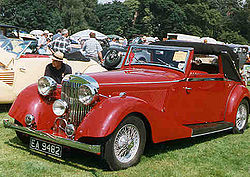
Sports car
A sports car is a small, usually two seat, two door automobile designed for high speed driving and maneuverability....
s and commercial vehicle
Commercial vehicle
A commercial vehicle is a type of motor vehicle that may be used for transporting goods or passengers. The European Union defines "commercial motor vehicle" as any motorised road vehicle, which by its type of construction and equipment is designed for, and capable of transporting, whether for...
s, based in the Lyng
Lyng, West Midlands
Lyng is a residential area of West Bromwich in the West Midlands of England. It is situated in the south of the town near the border with Oldbury - and part of Oldbury's Ring Road actually borders the southern part of the area....
– West Bromwich
West Bromwich
West Bromwich is a town within the Metropolitan Borough of Sandwell, in the West Midlands, England. It is north west of Birmingham lying on the A41 London-to-Birkenhead road. West Bromwich is part of the Black Country...
(in the West Midlands
West Midlands (region)
The West Midlands is an official region of England, covering the western half of the area traditionally known as the Midlands. It contains the second most populous British city, Birmingham, and the larger West Midlands conurbation, which includes the city of Wolverhampton and large towns of Dudley,...
, west of Birmingham
Birmingham
Birmingham is a city and metropolitan borough in the West Midlands of England. It is the most populous British city outside the capital London, with a population of 1,036,900 , and lies at the heart of the West Midlands conurbation, the second most populous urban area in the United Kingdom with a...
). The Jensen brothers (Alan and Richard, born in Moseley, Birmingham) were previously employed in the bodyshop of Patrick Motors, Selly Oak, Birmingham in a building which is still standing next to the University of Birmingham campus. A new version of the legendary Jensen Interceptor sports car will be bringing manufacturing back to the former Jaguar motor plant in Browns Lane, Coventry.
Foundation
Jensen began as a small coachbuilding firm run by brothers Richard and Alan Jensen; they bought out the body works of W.J. Smiths & Sons where they worked after the owner's death and renamed it Jensen Motors in 1934. They built exclusive customised bodies for standard cars produced by several manufacturers of the day including MorrisMorris Motor Company
The Morris Motor Company was a British car manufacturing company. After the incorporation of the company into larger corporations, the Morris name remained in use as a marque until 1984 when British Leyland's Austin Rover Group decided to concentrate on the more popular Austin marque...
, Singer
Singer (car)
Singer was an automobile company founded in 1905 in Coventry, England. It was acquired by the Rootes Group of the United Kingdom in 1956, who continued the brand until 1970...
, Standard
Standard Motor Company
The Standard Motor Company was founded in Coventry, England in 1903 by Reginald Walter Maudslay . The Standard name was last used in Britain in 1963, and in India in 1987.-1903–1914:...
, and Wolseley
Wolseley Motor Company
The Wolseley Motor Company was a British automobile manufacturer founded in 1901. After 1935 it was incorporated into larger companies but the Wolseley name remained as an upmarket marque until 1975.-History:...
. In 1934 they were commissioned by American film actor Clark Gable
Clark Gable
William Clark Gable , known as Clark Gable, was an American film actor most famous for his role as Rhett Butler in the 1939 Civil War epic film Gone with the Wind, in which he starred with Vivien Leigh...
to design and build a car for him based on a Ford
Ford Motor Company
Ford Motor Company is an American multinational automaker based in Dearborn, Michigan, a suburb of Detroit. The automaker was founded by Henry Ford and incorporated on June 16, 1903. In addition to the Ford and Lincoln brands, Ford also owns a small stake in Mazda in Japan and Aston Martin in the UK...
V-8 chassis. The resultant car won them much acclaim and stimulated huge interest in their work including a deal with Ford to produce a run of Jensen-Fords with Jensen bodywork with a Ford chassis and engine. In 1934 they also started to design their first true production car under the name White Lady. This evolved into the Jensen S-type
Jensen S-type
The Jensen S-type was a car built by Jensen Motors from 1936 until 1941 as both a saloon and a convertible. It was the firm's first volume production car, based on Ford motors from the United States, and chassis parts from Ford of Britain sourced through M B K Motors. The car was built on a steel...
which went into production in 1935.
Commercial vehicles
In the late 1930s Jensen diversified into the production of commercial vehicles under the marque JNSN, including the manufacture of a series of innovotive lightweight trucks, built with aluminium alloys, for the Reynolds Tube CompanyReynolds Cycle Technology
Reynolds Cycle Technology is a manufacturer of tubing for bicycle frames and other bicycle components based in Birmingham, England established in 1898.-History:...
and the prototype for the articulated Jen-Tug which went into production in the late 1940s.
During World War II
World War II
World War II, or the Second World War , was a global conflict lasting from 1939 to 1945, involving most of the world's nations—including all of the great powers—eventually forming two opposing military alliances: the Allies and the Axis...
Jensen concentrated on the war effort and produced components for military vehicles including the turrets for tanks, and on the production of specialised ambulances and fire-engines.
After the war production of the Jen-Tug thrived and Jensen also produced a new range of JNSN lightweight diesel trucks and chassis which were used for a variety of vehicles including pantechnicons and bus
Bus
A bus is a road vehicle designed to carry passengers. Buses can have a capacity as high as 300 passengers. The most common type of bus is the single-decker bus, with larger loads carried by double-decker buses and articulated buses, and smaller loads carried by midibuses and minibuses; coaches are...
es. In the 1950s Jensen were chosen by the British Motor Corporation
British Motor Corporation
The British Motor Corporation, or commonly known as BMC was a vehicle manufacturer from United Kingdom, formed by the merger of the Austin Motor Company and the Nuffield Organisation in 1952...
(BMC) to build the bodies for the four-wheel-drive Austin Gipsy
Austin Gipsy
The Austin Gipsy was Austin's attempt at an off-road capable vehicle to compete with Rover's Land Rover.-History:Austin picked the name with an "I" spelling rather than gypsy....
.
Sports cars
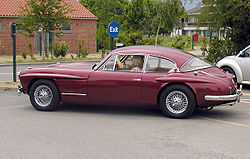
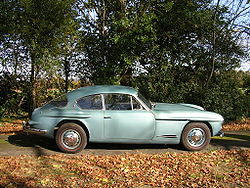
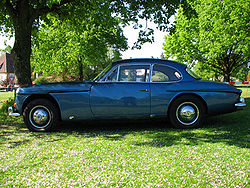
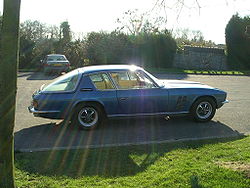
Jensen PW
The Jensen PW is a saloon car built by Jensen Motors from 1946 through 1952. The PW stood for Post-War, as the car was the first model built by Jensen after the Second World War. A convertible model was also built alongside the hardtop saloon....
(a luxury saloon). Few were produced since raw materials were still in short supply. Also in 1946 body designer Eric Neale
Eric Neale
Eric Neale was a British car designer.-Biography:Born in Halesowen, Worcestershire and educated at Halesowen Grammar School...
joined the company from Wolseley
Wolseley Motor Company
The Wolseley Motor Company was a British automobile manufacturer founded in 1901. After 1935 it was incorporated into larger companies but the Wolseley name remained as an upmarket marque until 1975.-History:...
and his first project was the more modern coupe
Coupé
A coupé or coupe is a closed car body style , the precise definition of which varies from manufacturer to manufacturer, and over time...
which followed in 1950, named the Interceptor
Jensen Interceptor (1950)
The first generation of Jensen Interceptor was the second car to be made by Jensen Motors after World War II and was produced from 1950 to 1957. Jensen later reused the name for a different car ....
, which was built until 1957. In 1955, Jensen started production of Neale's masterpiece, the 541
Jensen 541R
The Jensen 541R is a closed four-seater GT-class car built in the United Kingdom by Jensen between 1957 to 1960.The original aluminium prototype appeared in 1953 as the 541 at the London Motor Show, although this changed to glassfibre for all production cars...
, which used the then-revolutionary material of fiberglass
Fiberglass
Glass fiber is a material consisting of numerous extremely fine fibers of glass.Glassmakers throughout history have experimented with glass fibers, but mass manufacture of glass fiber was only made possible with the invention of finer machine tooling...
for its bodywork. The 541
Jensen 541S
The Jensen 541S was Jensen Motors luxury GT model of the Jensen 541 series, being 4" wider than the 541R, which had the advantages of making the interior roomier and improving the roadholding...
was replaced by another Neale design, the CV8
Jensen CV8
The Jensen C-V8 is a sports car produced by Jensen Motors.Launched in October 1962, it was the successor to the similarly styled 541 series of Jensen motorcars and shared their use of fibreglass as a body material ....
in 1962, which replaced the Austin
Austin Motor Company
The Austin Motor Company was a British manufacturer of automobiles. The company was founded in 1905 and merged in 1952 into the British Motor Corporation Ltd. The marque Austin was used until 1987...
-sourced straight-6
Straight-6
The straight-six engine or inline-six engine is a six-cylinder internal combustion engine with all six cylinders mounted in a straight line along the crankcase...
of the previous cars with a 6 litre American Chrysler V8. This large engine in such a lightweight car made the Jensen one of the fastest four-seaters of the time.
For its replacement, the Interceptor
Jensen Interceptor
The Jensen Interceptor was a sporting GT-class car hand-built in the United Kingdom by Jensen Motors between 1966 and 1976. The Interceptor name had been used previously by Jensen for an earlier car made between 1950 and 1957...
(launched in 1966), Jensen turned to the Italian coachbuilder, Carrozzeria Touring
Carrozzeria Touring
Carrozzeria Touring is an automobile coachbuilder established on March 25, 1926 in Milan, Italy by Felice Bianchi Anderloni and Gaetano Ponzoni...
, for the body design, and to steel for the material. The bodyshells themselves were built by Vignale
Vignale
Vignale was an Italian automobile coachbuilder company. Carrozzeria Alfredo Vignale was established in 1948 at Via Cigliano, Turin by Alfredo Vignale in Grugliasco, near Turin ....
of Italy and later by Jensen. The same 383 cu in (6.3 l) Chrysler wedge-head powerplant was used in the earlier cars with the later cars moving to the 440 cu in (7.2 l) in engine. The Interceptor was offered in fastback
Fastback
A fastback is a car body style whose roofline slopes continuously down at the back. The word can also designate the car itself. The style is seen on two-door coupés as well as four-door sedans.-History:...
, convertible and (rare) coupé versions. The fastback was by far the most popular with its large, curving wrap-around rear window that doubled as a tailgate
Tailgate
Tailgate is an American English word denoting the door or 'gate' at the back of a wagon, pickup truck, SUV or other similar type of vehicle that is hinged at the bottom and can be opened for the convenience in loading cargo into the rear of the vehicle...
.
Related to the Interceptor was another car, the Jensen FF
Jensen FF
The Jensen FF was a four-wheel drive Grand Tourer car produced by the British manufacturer Jensen Motors between 1966 and 1971. It was the first non all-terrain production car equipped with 4WD and an anti-lock braking system — the Dunlop Maxaret mechanical system used hitherto only on...
, the letters standing for Ferguson Formula, Ferguson Research
Ferguson Research Ltd.
Harry Ferguson Research Limited was a British company founded by Harry Ferguson who was mostly known as "the father of the modern farm tractor"...
being the inventor of the full-time all wheel drive system adopted, the first on a production sports car. Also featured was the Dunlop Maxaret
Maxaret
Dunlop's Maxaret was the first anti-lock braking system to be widely used. Introduced in the early 1950s, Maxaret was rapidly taken up in the aviation world, after testing found a 30% reduction in stopping distances, and the elimination of tire bursts or flat spots due to skids...
anti-lock braking system
Anti-lock braking system
An anti-lock braking system is a safety system that allows the wheels on a motor vehicle to continue interacting tractively with the road surface as directed by driver steering inputs while braking, preventing the wheels from locking up and therefore avoiding skidding.An ABS generally offers...
in one of the first uses of ABS in a production car. Outwardly, the only differences from the Interceptor were four extra inches of length (all ahead of the windscreen) and a second row of air vents behind the front wheels. The small number of 320 FFs were constructed, and production ceased in 1971.
Other projects

Austin Motor Company
The Austin Motor Company was a British manufacturer of automobiles. The company was founded in 1905 and merged in 1952 into the British Motor Corporation Ltd. The marque Austin was used until 1987...
and Jensen, the Austin A40 Sports
Austin A40 Sports
See Austin A40 for other A40 models.The Austin A40 Sports debuted at the 1949 London Motor Show as a four-passenger, aluminium-bodied convertible version of the Austin A40 — carrying an Austin of England nameplate, bearing the marque's Flying A hood ornament, and designed and manufactured in...
originated when Austin's chairman Leonard Lord
Leonard Lord
Leonard Percy Lord, 1st Baron Lambury KBE was a captain of the British motor industry.-Background and education:...
, upon seeing the Interceptor
Jensen Interceptor (1950)
The first generation of Jensen Interceptor was the second car to be made by Jensen Motors after World War II and was produced from 1950 to 1957. Jensen later reused the name for a different car ....
, requested that Jensen develop a body that could use the A40 mechanicals. The resulting body-on-frame
Body-on-frame
Body-on-frame is an automobile construction method. Mounting a separate body to a rigid frame that supports the drivetrain was the original method of building automobiles, and its use continues to this day. The original frames were made of wood , but steel ladder frames became common in the 1930s...
A40 Sports – which debuted at the 1949 London Motor Show – had been designed by Eric Neale
Eric Neale
Eric Neale was a British car designer.-Biography:Born in Halesowen, Worcestershire and educated at Halesowen Grammar School...
, an ex-Wolseley
Wolseley Motor Company
The Wolseley Motor Company was a British automobile manufacturer founded in 1901. After 1935 it was incorporated into larger companies but the Wolseley name remained as an upmarket marque until 1975.-History:...
stylist who had joined Jensen in 1946. During production, the A40 Sports' aluminium bodies were built by Jensen and transported to Austin's Longbridge plant
Longbridge plant
The Longbridge plant is an industrial complex situated in the Longbridge area of Birmingham, United Kingdom. It is currently owned by SAIC Group and is a manufacturing and research and development facility for its MG Motor subsidiary....
for final assembly. The A40 Sports had been intended as more of a sporty touring car and not a sports car per se, and over 4000 examples were manufactured from 1951–1953.
Austin-Healey 100: Although Jensen's design for a new Austin-based sports-car was rejected by the British Motor Corporation
British Motor Corporation
The British Motor Corporation, or commonly known as BMC was a vehicle manufacturer from United Kingdom, formed by the merger of the Austin Motor Company and the Nuffield Organisation in 1952...
(BMC) in 1952 in favour of a design provided by Donald Healey
Donald Healey Motor Company
-History:It was formed in 1945 by Donald Healey, a renowned auto engineer and successful racing driver. It was formed after Healey discussed sports car design with Achille Sampietro, a chassis specialist for high performance cars and Ben Bowden, a body engineer, when all three worked at Humber...
, Jensen did win the BMC contract to build the bodies for the resultant Austin-Healey 100
Austin-Healey 100
The Austin-Healey 100 is a sports car built from 1953 until 1959. There were two models, the original four-cylinder Austin-Healey 100, built 1953-1956, and the six-cylinder Austin-Healey 100-6, built 1956-1959....
from 1952 until 1956.
Volvo P1800: In 1960 Jensen won a contract from Volvo
Volvo Cars
Volvo Car Corporation, or Volvo Personvagnar AB, is a Swedish automobile manufacturer founded in 1927, in Gothenburg, Sweden. It is owned by Zhejiang Geely Holding Group. Volvo was originally formed as a subsidiary company to the ball bearing maker SKF. When Volvo AB was introduced on the Swedish...
to assemble and finish the bodies for their P1800
Volvo P1800
-History:The project was started in 1957 because Volvo wanted a sports car, despite the fact that their previous attempt, the P1900, had been a disaster, with only 68 cars sold. The man behind the project was an engineering consultant to Volvo, Helmer Petterson, who in the 1940s was responsible for...
coupé. Pressed Steel
Pressed Steel Company
The Pressed Steel Company Limited was a British car body manufacturing company founded at Cowley near Oxford in 1926 as a joint venture between William Morris, the Budd Corporation and an American bank. Today at what was the company's Cowley plant, the BMW new MINI is assembled, this site is...
manufactured the body-shells at their Linwood
Linwood
Linwood is a small town in Renfrewshire, Scotland, 14 miles south-west of Glasgow.Linwood is a commuter town, with proximity to Glasgow International Airport and the M8 motorway to Glasgow and Edinburgh...
plant in Scotland
Scotland
Scotland is a country that is part of the United Kingdom. Occupying the northern third of the island of Great Britain, it shares a border with England to the south and is bounded by the North Sea to the east, the Atlantic Ocean to the north and west, and the North Channel and Irish Sea to the...
and shipped them to Jensen in West Bromwich to be finished, painted and trimmed, before then being shipped to Sweden
Sweden
Sweden , officially the Kingdom of Sweden , is a Nordic country on the Scandinavian Peninsula in Northern Europe. Sweden borders with Norway and Finland and is connected to Denmark by a bridge-tunnel across the Öresund....
where Volvo completed the final build.
Sunbeam Tiger: In the early 1960s Jensen were also involved in the development and production of the Sunbeam Tiger
Sunbeam Tiger
The Sunbeam Tiger was a muscle car version of the British Rootes Group's Sunbeam Alpine roadster.-Development:The West Coast Sales Manager of Rootes American Motors Inc., Ian Garrad, realized that the Alpine's image was that of a touring car rather than a sports car, and he set about changing its...
.
Changing ownership
The company had come under the control of the Norcros Group in 1959 and following disagreements Alan and Richard Jensen resigned in 1966. The American car distributor Kjell QvaleKjell Qvale
Kjell Qvale is a Norwegian-American business executive. Qvale is one of the key figures in the creation of the Jensen-Healey. Qvale became the first distributor for Jaguar on the Pacific West Coast. Qvale is one of the founders of the San Francisco Auto Show.-Early life:Kjell Qvale was born in...
became the majority shareholder in 1970 and brought in Donald Healey
Donald Healey
Donald Mitchell Healey CBE was a noted English rally driver, automobile engineer, and speed record holder.- Early life :...
as chairman.
By 1975, the company's future was under threat, with the redundancy of 700 workers - two thirds of its workforce.
Jensen Motors ceased trading in May 1976. Two new companies: Jensen Special Products (JSP) and Jensen Parts & Service Limited (JP&S) were created to pick up the pieces of Jensen Motors. JSP was created as a specialist engineering and design company from Jensen's development department. JP&S was created to provide parts and service to the existing Jensen customer base. Both JSP and JP&S were bought by a holding company
Holding company
A holding company is a company or firm that owns other companies' outstanding stock. It usually refers to a company which does not produce goods or services itself; rather, its purpose is to own shares of other companies. Holding companies allow the reduction of risk for the owners and can allow...
, Britcar Holdings. In 1982 JP&S, with the rights to use the Jensen brand names, was sold to Ian Orford who put the Interceptor back into production as the Mk IV.
Jensen Parts and Service was renamed Jensen Cars Ltd and 11 cars were made before the company was sold to Unicorn Holdings of Stockport and a Mk V Interceptor was proposed but never materialised although a few more Mk IVs were built.
Revival hopes
A revival in 2001 was short lived. By the end of 2002 production on their only model – the £40,000 S-V8Jensen S-V8
The Jensen S-V8 is the most recent in a series of Jensen cars. After a £9 million investment the car was launched at the 1998 British International Motor Show, with an initial production run of 300 deposit paid vehicles planned at a selling price of £40,000 each, troubles with manufacture...
– had ceased.
In April 2010 Jensen International Automotive (JIA) was founded. This new company will buy old Jensen Interceptors, and sell them as new ones after a complete restoration, with new engine and interior trim.
Jensen cars
- Jensen S-typeJensen S-typeThe Jensen S-type was a car built by Jensen Motors from 1936 until 1941 as both a saloon and a convertible. It was the firm's first volume production car, based on Ford motors from the United States, and chassis parts from Ford of Britain sourced through M B K Motors. The car was built on a steel...
(1936–1941) - Jensen H-typeJensen H-typeThe Jensen H-type is a saloon car built by Jensen Motors from 1938 through 1945. The car was built on a strengthened Ford chassis and used aluminum for the body panels. The car was sold with a OHV Inline 8 built by Nash...
(1938–1945) - Jensen PWJensen PWThe Jensen PW is a saloon car built by Jensen Motors from 1946 through 1952. The PW stood for Post-War, as the car was the first model built by Jensen after the Second World War. A convertible model was also built alongside the hardtop saloon....
(1946–1952) - Jensen InterceptorJensen Interceptor (1950)The first generation of Jensen Interceptor was the second car to be made by Jensen Motors after World War II and was produced from 1950 to 1957. Jensen later reused the name for a different car ....
(1950–1957) - Jensen 541Jensen 541The Jensen 541 was first exhibited at the London Motor Show in October 1953: production started in 1954. In October 1954 a cabriolet version was introduced....
(1954–1959) - Jensen 541RJensen 541RThe Jensen 541R is a closed four-seater GT-class car built in the United Kingdom by Jensen between 1957 to 1960.The original aluminium prototype appeared in 1953 as the 541 at the London Motor Show, although this changed to glassfibre for all production cars...
(1957–1960) - Jensen 541SJensen 541SThe Jensen 541S was Jensen Motors luxury GT model of the Jensen 541 series, being 4" wider than the 541R, which had the advantages of making the interior roomier and improving the roadholding...
(1960–1963) - Jensen CV8Jensen CV8The Jensen C-V8 is a sports car produced by Jensen Motors.Launched in October 1962, it was the successor to the similarly styled 541 series of Jensen motorcars and shared their use of fibreglass as a body material ....
(1962–1966) - Jensen P66Jensen P66Jensen P66 is a model range planned by Jensen Motors in the 1960s, which was aborted after two models were made and one was exhibited at the London Motor Show....
(1965 prototype only) - Jensen InterceptorJensen InterceptorThe Jensen Interceptor was a sporting GT-class car hand-built in the United Kingdom by Jensen Motors between 1966 and 1976. The Interceptor name had been used previously by Jensen for an earlier car made between 1950 and 1957...
(1966–1976) - Jensen FFJensen FFThe Jensen FF was a four-wheel drive Grand Tourer car produced by the British manufacturer Jensen Motors between 1966 and 1971. It was the first non all-terrain production car equipped with 4WD and an anti-lock braking system — the Dunlop Maxaret mechanical system used hitherto only on...
(1966–1971) - Jensen-HealeyJensen-HealeyThe Jensen-Healey is a two-seater convertible sports car that was originally produced between 1972 and 1976 by Jensen Motors, Ltd. Roughly 10,000 were produced at West Bromwich, England. A related fastback, the Jensen GT was introduced in 1975.-Design:...
(1972–1975) - Jensen GT (1975–1976)
- Jensen S-V8Jensen S-V8The Jensen S-V8 is the most recent in a series of Jensen cars. After a £9 million investment the car was launched at the 1998 British International Motor Show, with an initial production run of 300 deposit paid vehicles planned at a selling price of £40,000 each, troubles with manufacture...
(2001)
See also
- Jensen-HealeyJensen-HealeyThe Jensen-Healey is a two-seater convertible sports car that was originally produced between 1972 and 1976 by Jensen Motors, Ltd. Roughly 10,000 were produced at West Bromwich, England. A related fastback, the Jensen GT was introduced in 1975.-Design:...
- Volvo P1800Volvo P1800-History:The project was started in 1957 because Volvo wanted a sports car, despite the fact that their previous attempt, the P1900, had been a disaster, with only 68 cars sold. The man behind the project was an engineering consultant to Volvo, Helmer Petterson, who in the 1940s was responsible for...
- Sunbeam TigerSunbeam TigerThe Sunbeam Tiger was a muscle car version of the British Rootes Group's Sunbeam Alpine roadster.-Development:The West Coast Sales Manager of Rootes American Motors Inc., Ian Garrad, realized that the Alpine's image was that of a touring car rather than a sports car, and he set about changing its...
- Austin A40 SportsAustin A40 SportsSee Austin A40 for other A40 models.The Austin A40 Sports debuted at the 1949 London Motor Show as a four-passenger, aluminium-bodied convertible version of the Austin A40 — carrying an Austin of England nameplate, bearing the marque's Flying A hood ornament, and designed and manufactured in...
- Austin-Healey 100Austin-Healey 100The Austin-Healey 100 is a sports car built from 1953 until 1959. There were two models, the original four-cylinder Austin-Healey 100, built 1953-1956, and the six-cylinder Austin-Healey 100-6, built 1956-1959....
- Austin-Healey 3000Austin-Healey 3000The Austin-Healey 3000 is a British sports car built from 1959 to 1967, and is the best known of the "big" Healey models. The car's bodywork was made by Jensen Motors, and the vehicles were assembled at the BMC Abingdon works....

